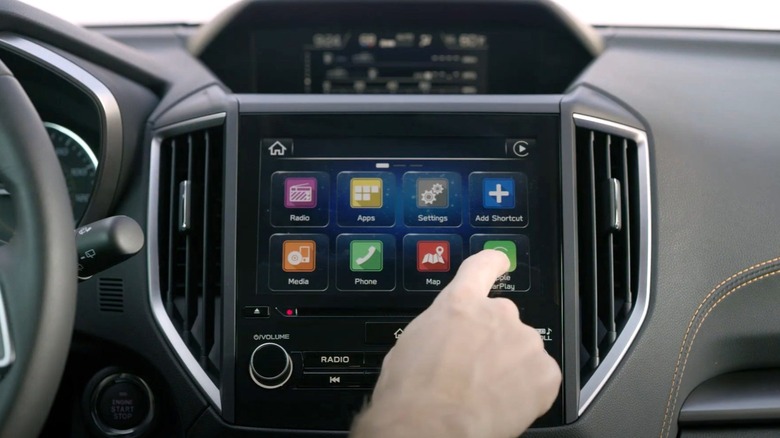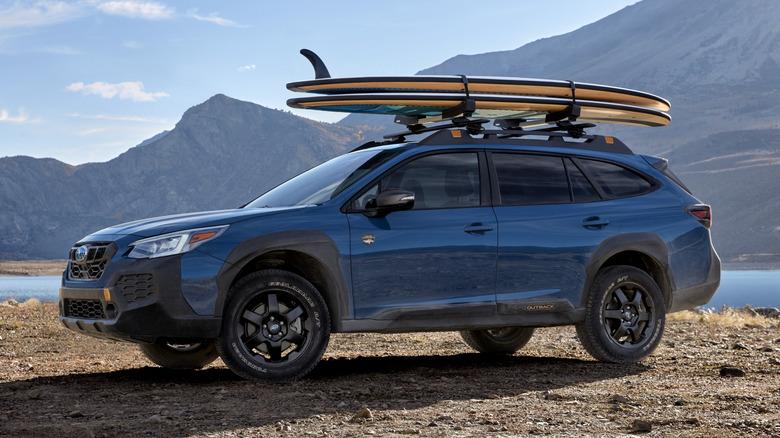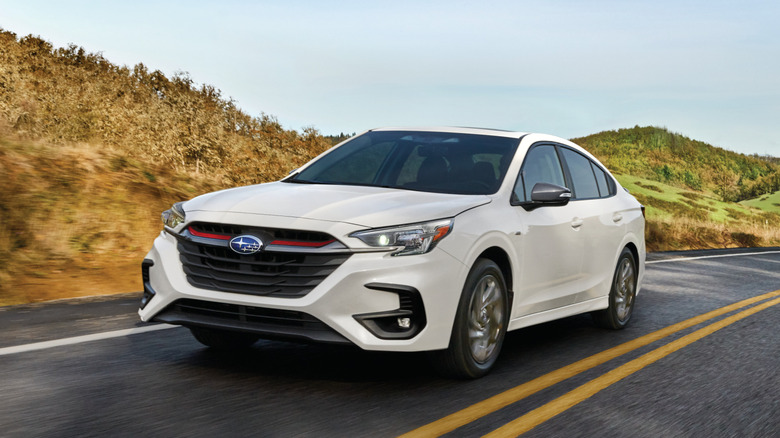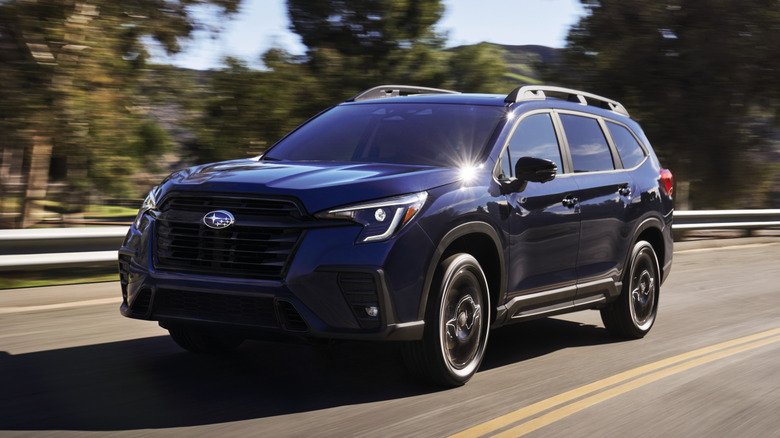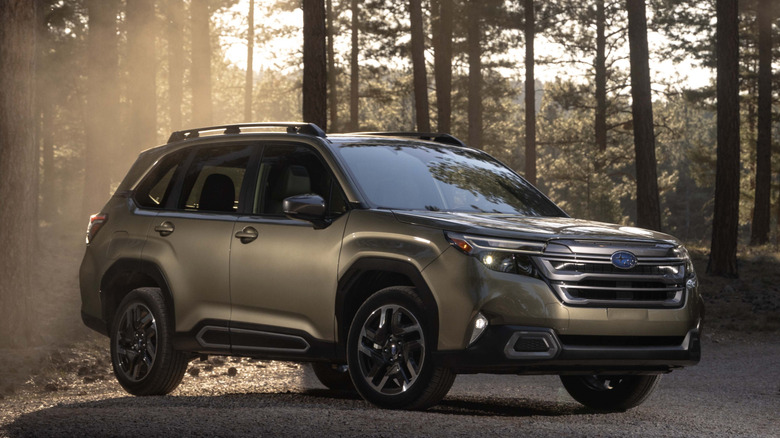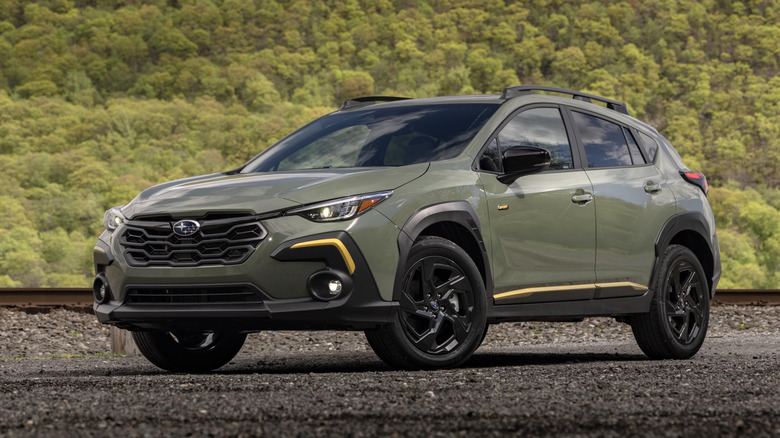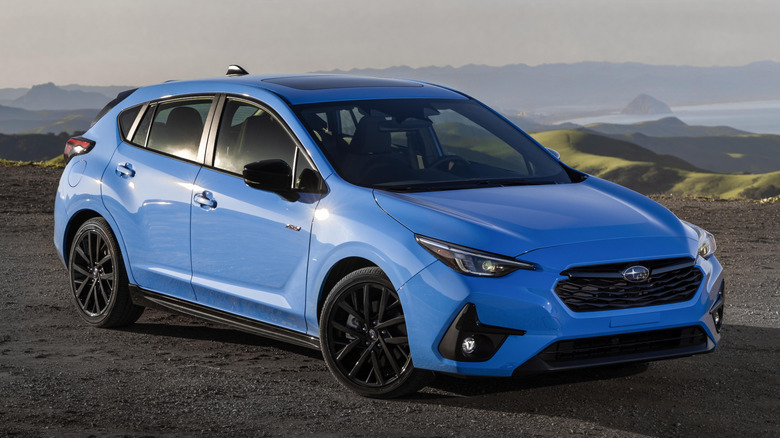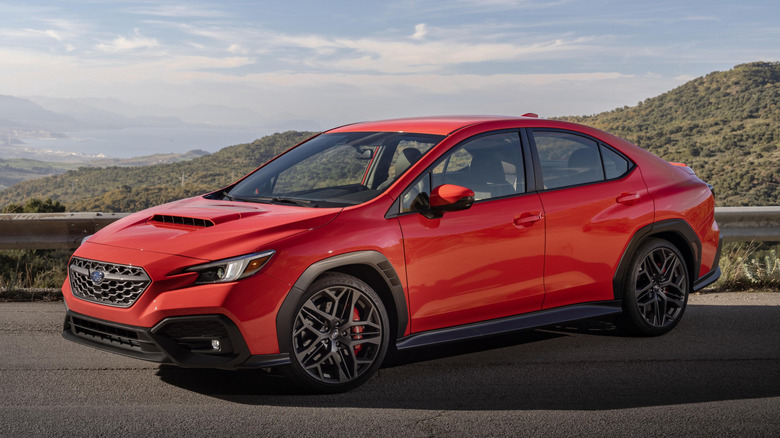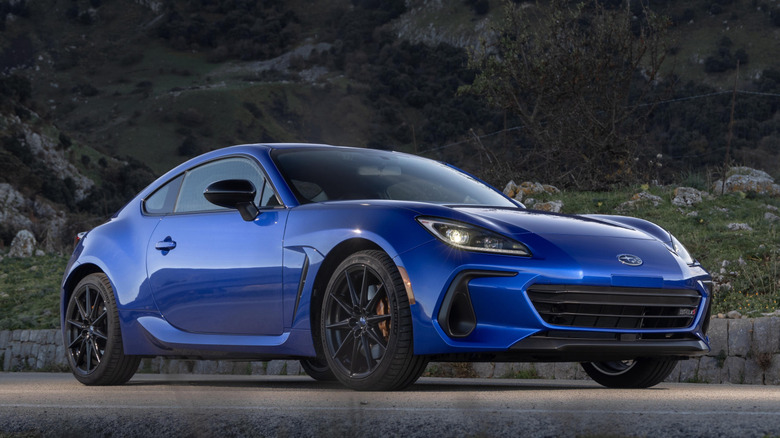Which Subaru Models Come With Starlink In-Vehicle Technology?
In-vehicle infotainment has evolved in leaps and bounds since the days of in-car vinyl record players back in the 1950s and 1960s. Today most, if not all, cars sport at least one touchscreen, allowing users to access and take advantage of a wealth of entertainment, navigation, and communication features via systems such as Android Auto and fancy built-in voice assistants.
Subaru is, of course, no exception to this trend. The Japanese carmaker has Starlink, an in-vehicle infotainment and security system available on most of its gasoline-powered vehicles. Subaru bundles two systems under the Starlink banner: Starlink Safety and Security and Starlink Multimedia. Safety and Security offers features such as collision notification, roadside assistance, stolen vehicle recovery, and several types of alerts, including speed and curfews — handy for parents keeping an eye on teenagers, although the latter may not always be appreciative of the constant observation.
Starlink Multimedia, on the other hand, is a touchscreen-powered infotainment system akin to those in other modern vehicles. There's an entry-level Multimedia system with dual 7.0-inch screens and two versions with the newer 11.6-inch screen: Starlink Multimedia Plus and Starlink Multimedia Navigation. All versions of Starlink Multimedia support Bluetooth, Apple CarPlay, and Android Auto, but you're looking at the higher-end implementations if you want features like in-vehicle GPS and traffic updates. So, if you're trying to figure out what's available on which car, read on for a breakdown of all Starlink-equipped Subarus.
Subaru Outback
The legendary Subaru Outback has been a fixture in the company's stable since it launched as an offroad-friendly trim level for the Subaru Legacy back in 1995. Humble beginnings to be sure, but that wouldn't last for long: Subaru turned the Outback into a standalone model in 2000, laying the groundwork for 25 years of sport utility wagon success and eventually cementing the nameplate as one of the most successful vehicles in Subaru history.
Subaru offers a staggering nine trim levels for the 2025 Outback, from the $28,895 base model all the way up to the top-spec, turbocharged Touring XT and its $42,795 MSRP. All nine trim levels have Subaru Starlink Multimedia, although implementations differ: The base has a 7.0-inch screen, while Premium — the trim level directly above Base — and higher 2025 Outbacks get an 11.6-inch Starlink screen. Even there, though, the Starlink features differ between trim levels: Limited and Touring (and their XT counterparts) get Starlink Multimedia Navigation, while the more affordable non-base trims make do with Starlink Multimedia Plus.
The base model also lacks Starlink Safety and Security and features such as Subaru's automatic reverse braking, distraction mitigation, and blind-spot detection. To be fair, though, the Premium model also lacks these features; you'll have to pony up for the $40,345 Touring edition to get all the goodies. We reviewed the 2024 Subaru Outback Touring XT earlier this year and liked it enough to give it a SlashGear Select award, although our reviewer had issues with Starlink's iffy connectivity and tendency to freeze.
Subaru Legacy
2025 is going to be the final year for the Subaru Legacy, the company's longest-running model (and the first that it built in the U.S.). The sensible and ultra-reliable Legacy has been a roaring success in the years since its 1989 debut, with 1.3 million sold in the U.S. alone and global production well exceeding the 3 million unit mark.
Subaru offers the Legacy in five trim levels for this final production year. Prices start at $24,895 for the base model, with Premium, Limited, and Sport trims increasing levels of luxury and features before topping out with the turbocharged $38,195 Touring XT trim level. As with the Outback, the base Legacy has the entry-level dual-7.0-inch screen setup, which means that base Legacy owners get access to Starlink Multimedia but not Starlink Safety and Security.
Premium, Limited, Sport, and Touring XT trim levels get Subaru's newer 11.6-inch vertical touchscreen, which enables all the extras of Subaru's Starlink Multimedia Plus and Multimedia Navigation infotainment systems (the latter standard on Limited and Touring XT trims). The 11.6-inch screen goes hand-in-hand with Starlink Safety and Security, so you'll want to get the Premium trim level at least if you're interested in the latter. Of course, core brand features such as all-wheel drive and Subaru's EyeSight are standard across all trim levels, which Chris Davies appreciated when he took the 2025 Subaru Legacy out for a spin.
Subaru Ascent
The Ascent is Subaru's entry into the midsize SUV market, ranking as both the largest — thanks to its 113.8-inch wheelbase — and newest model on this list, having entered production in 2018 for the 2019 model year. It's a notable step up from other Subaru SUVs like the Forester, with more room, a more powerful engine, and much better towing capacity.
Nothing in Subaru's current lineup matches the 2025 Outback's nine trim levels, but the 2025 Ascent comes the closest with six. You get Premium, Onyx Edition, Limited, Bronze Edition, Touring, and Onyx Edition Touring trim levels, with Premium and Limited also available in eight-seater form. As you might be able to guess from the lack of a base model, the Ascent is a bit more of a premium offering than Subaru's other vehicles, designed as it is to compete with the best midsize SUVs on the market.
The Ascent is one of Subaru's pricier offerings, starting at $38,795 and maxing out at just under $50,000 in the Onyx Edition Touring trim. All models get Subaru's 2.4-liter turbocharged boxer, good for 260 hp and 277 lb-ft of torque. Similarly, all six trim levels get Subaru's full Starlink package, with the 11.6-inch Starlink Multimedia Plus infotainment system on the Premium and Onyx Edition trim levels, and Starlink Multimedia Navigation standard starting from the Limited trim level. Starlink Safety and Security comes from the factory throughout the range.
Subaru Forester
Subaru's Forester is one of the two compact crossover SUVs in its lineup for 2025, sharing the crossover limelight with the Crosstrek. The Forester is the older of the two models, having debuted in 1997, and is also arguably the slightly more practical of the two, with more passenger and cargo room alongside road trip-friendly amenities such as heated rear seats.
The 2025 Subaru Forester comes in five trim levels, with the base model the only one with a sub-$30,000 MSRP (not including any extra charges, of course). The base model gets the simpler Starlink Multimedia setup with dual 7.0-inch screens common to other entry-level Subaru models, with the Premium, Sport, and Limited trim levels getting Starlink Multimedia Plus and its 11.6-inch screen. Only the high-end Touring trim level, with its $39,995 MSRP, gets Starlink Multimedia Navigation.
Starlink Safety and Security is, as expected, absent on the base trim level, given its simpler Starlink hardware. The basic Forester also has a four-speaker sound system — compared to at least six on all the other trim levels — and lacks 4G LTE Wi-Fi, alongside other small niceties like illuminated USB ports and fold-down armrests in the rear. All five trim levels have a 2.5-liter boxer engine under the hood that produces 180 hp and 178 lb-ft of torque. You don't get any turbos here, unfortunately, but that's likely not going to bother the Forester's target audience.
Subaru Crosstrek
We go from one crossover to the other, and one of the newer models in Subaru's current lineup. The Crosstrek debuted in the U.S. in 2013 as the XV Crosstrek and quickly became the automaker's best-selling vehicle. The Crosstrek won consumers over with its combination of crossover appeal, a good day-to-day experience, and genuine off-road capability; a compelling combination, as we found out when we tested the 2024 Subaru Crosstrek Sport.
Sport is one of the five trim levels available, sitting in the middle of the pack. As with most other Subarus, the base level Crosstrek starts things off, with Premium, Sport, Limited, and off-road focused Wilderness trim levels following in ascending price order. The two most affordable trim levels, base and Premium, have a 2.0-liter boxer engine that makes 152 hp, while the latter three get the same 182-hp 2.5-liter engine available in the Forester.
The base Crosstrek has the older 7.0-inch Starlink Multimedia system and lacks Starlink Safety and Security, while the other four trims all have the 11.6-inch Multimedia Plus and all of Subaru's Starlink safety features as standard. None of the Crosstrek models come with Starlink Multimedia Navigation from the factory, but it is available as an option on the Crosstrek Limited. The Crosstrek Wilderness doesn't get in-vehicle GPS, but that's not too surprising: Between changes like increased ground clearance, higher final drive, and a 3,500-pound towing capacity, the Crosstrek Wilderness is one for off-road trails, not navigating the urban jungle. So it's a reasonable omission if you ask us.
Subaru Impreza
What the Legacy is to the Outback, the Impreza is to the Crosstrek. The Impreza is the standard, non-lifted original on which the Crosstrek is based, with the two models sharing nearly identical bodywork and length, wheelbase, and width measurements. The Impreza nameplate has been around much longer, of course, with six generations of the four-door car having left Subaru factories since its early-1990s debut, but the similarities in the current generations of the two models are plain to see.
Subaru has opted to keep the trim levels much simpler for its cars, and the 2024 Impreza is available in three trim levels. We start with the $22,995 basic model, step up to the $24,995 Impreza Sport, and end with the top-of-the-line Impreza RS, which has a still-reasonable MSRP of $27,885. The RS is the only one of the three with Subaru's 2.5-liter boxer engine, with the other two making do with the 152-hp 2.0-liter boxer also available in the lower-end Crosstrek trims.
Befitting its budget-oriented pricing, the Impreza models come with either basic Starlink Multimedia — on the base level model — or Starlink Multimedia Plus, with no option for the more premium Starlink Multimedia Navigation. Starlink Safety and Security is, as ever, missing on the most affordable trim, but is present on the Sport and RS. All-wheel-drive and traction aids are standard across the board, though, and the Impreza's grippy nature was one of Chris Davies' high points when he took the 2024 Subaru Impreza RS for a spin back in 2023.
Subaru WRX
There are few three-letter initials more loved in the automotive world than WRX. The WRX started life as a high-performance, rally-minded variant of the Impreza, with three iconic generations commonly known as the Hawkeye, Bugeye, and Blobeye going toe-to-toe with Mitsubishi's Lancer Evolution from the early 1990s well into the 2000s.
Subaru spun the WRX brand off into its own nameplate in 2015 with a hotter WRX STI version also available, in keeping with the tradition of the older Impreza-based WRX cars. The second-generation standalone WRX made its Japanese debut six years later in 2021, coming to the U.S. in 2022. The second-generation WRX received a beefier 2.4-liter turbocharged boxer engine making 271 hp and Subaru's then-new 11.6-inch Starlink infotainment system across all trim levels. It wasn't all good news, though, at least not for petrolheads: The second-generation WRX didn't get an STI version, with Subaru opting to discontinue the higher-performance version.
The presence of the 11.6-inch screen as standard means that all 2024 WRX models have the fancier Starlink Multimedia systems. The basic and Premium WRX have Starlink Multimedia Plus, while the higher-end Limited, TR, and GT trim levels get Starlink Multimedia Navigation. As with all other Subarus equipped with the 11.6-inch screen, Starlink Safety and Security is standard on all five WRX versions. We expect the 2025 Subaru WRX tS to be much the same here, although Subaru has yet to officially update its site to reflect the 2025 WRX lineup at the time of writing.
Subaru BRZ
Finally, we come to the odd one out in the current Subaru lineup, and in more ways than one. The Subaru BRZ debuted in 2012, the product of a joint venture between Subaru and Toyota. The result was two sports coupes that shared major components such as the engine, drivetrain, styling, and interiors but boasted notably different suspension tuning that gave each its own flavor.
The shared development and lineage also means that the BRZ has a slightly different in-vehicle infotainment setup than its Subaru siblings. Whereas other Subaru models either have dual 7.0-inch screens or one vertical 11.6-inch screen, the BRZ sports an 8.0-inch Starlink Multimedia Plus infotainment system, without the option for Starlink Multimedia Navigation. Starlink Safety and Security is missing entirely, too, with none of the three models — Premium, Limited, or tS — sporting Subaru's in-house safety system.
Another area where the BRZ stands out is its drivetrain: It's a two-wheel-drive car, delivering the 2.4-liter boxer engine's 228 hp to the road via the rear wheels. That makes the BRZ a hoot to drive, aided by what our Steven Ewing called "one of the best manual transmissions" when he reviewed the 2023 Subaru BRZ. That said, he also pointed out that the infotainment system was "outdated," and things don't seem to have changed much in the years since: We tested the 2025 Subaru BRZ tS and were once again disappointed by the Starlink implementation. But will you really care, given how fun the car is to drive? Possibly not.
